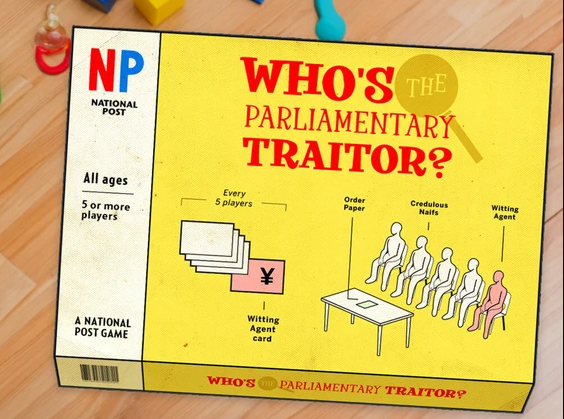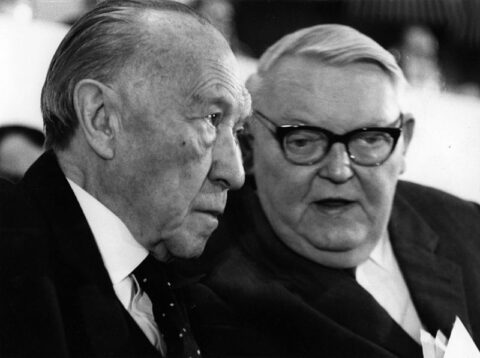In the National Post, Tristin Hopper presents the rulebook for an exciting new family game literally “ripped from the headlines” – Who’s the Parliamentary Traitor?

“To simulate what it’s like to go to work in a national parliament secretly housing foreign agents, the National Post presents a tongue-in-cheek instruction manual to play this group game: Who’s the Parliamentary Traitor?
Photo by Brice Hall”
WHAT YOU NEED TO PLAY:
- One large writing surface, such as a chalkboard, whiteboard or flip chart (THE ORDER PAPER)
- 20-70 note cards
- A timer
SETTING UP PLAY:
Gather at least five of your closest friends and have them sit in a line facing the ORDER PAPER. They will be divided into two categories: The WITTING AGENTS and the CREDULOUS NAIFS.To choose who among them will be the WITTING AGENTS, prepare a stack of IDENTITY CARDS equal to the number of players. On every fifth card, mark the symbol for the Chinese yuan (¥). In the case of five players, mark a single card, for 10 players, mark two, etc.
Shuffle the IDENTITY CARDS and distribute them among the players. Anyone receiving a “¥” is now a WITTING AGENT.
Set aside another stack of note cards to serve as MANDATE LETTERS. The text for each card is below. Shuffle the MANDATE LETTERS and place them face down.
RULES OF THE GAME:
Each round begins with a CANADA IS NOT BROKEN phase in which all players close their eyes, put their thumbs in their ears and bury their face for two minutes (the elapsed time to be marked with a timer). During this phase, the WITTING AGENTS open their eyes, stride over to the ORDER PAPER and write down a piece of binding public policy that damages Canada to the advantage of a hostile government (suggestions below).Once this act of treachery is done, the WITTING AGENTS return to their seats will pretend to wake up alongside them as if nothing happened.
Now begins the CONCERNED FOLLOW-UP phase. First, players must pull a MANDATE LETTER card that will determine conditions of discussion. Now, the parliamentarians must decide who among them is the foreign cat’s paw who has defaced their ORDER PAPER with disloyal policy. Uncomfortable questions are asked, accusations are made, and at the end of the round the players vote on who among them will be ejected as a traitor.
Only after the accused traitor is exiled will they show their IDENTITY CARD, revealing whether the accusations have been true, or whether they have been unjustly maligned.
Ejected players are then exiled to THE SENATE, a separated area of chairs where they are served port, ginger ale and black liquorice. They continue to participate in the CANADA IS NOT BROKEN and the CONCERNED FOLLOW-UP phases, but they no longer have a vote.





